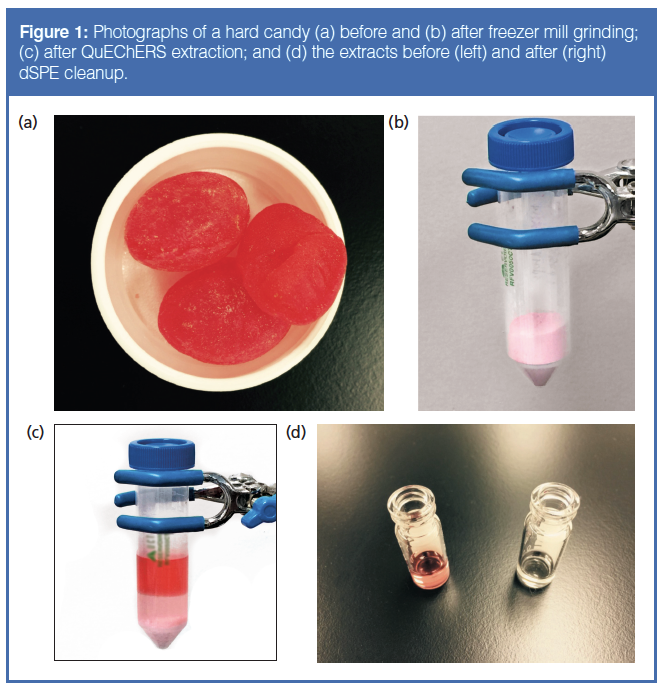Determination of Cannabinoid Content and Pesticide Residues in Cannabis Edibles and Beverages
Special Issues
As a result of the rapid growth of the cannabis industry, many testing laboratories are looking for efficient, reliable, and cost-effective analytical methods to analyze chemical residues, such as pesticides, mycotoxins, solvent residues, terpenes, and heavy metals, as well as cannabinoid concentration in cannabis-infused edibles and beverages. In this article, QuEChERS (quick, easy, cheap, effective, rugged, and safe), a sample preparation technique widely adopted in the food testing industry, is introduced to the discipline of forensic testing as a viable method for the extraction of pesticides and cannabinoids in various complex sample matrices. The claimed amounts of cannabinoids versus the actual amounts are compared, as well as the pesticide residue levels in edible and beverage samples.
Xiaoyan Wang, Danielle Mackowsky, Jody Searfoss, and Michael J. Telepchak, UCT, Bristol, Pennsylvania, USA
As a result of the rapid growth of the cannabis industry, many testing laboratories are looking for efficient, reliable, and cost-effective analytical methods to analyze chemical residues, such as pesticides, mycotoxins, solvent residues, terpenes, and heavy metals, as well as cannabinoid concentration in cannabis-infused edibles and beverages. In this article, QuEChERS (quick, easy, cheap, effective, rugged, and safe), a sample preparation technique widely adopted in the food testing industry, is introduced to the discipline of forensic testing as a viable method for the extraction of pesticides and cannabinoids in various complex sample matrices. The claimed amounts of cannabinoids versus the actual amounts are compared, as well as the pesticide residue levels in edible and beverage samples.
To date, 25 states and the District of Columbia in the United States have legalized the medical use of marijuana, while four states and the District of Columbia have also legalized the recreational use of marijuana (1). Although the federal government still classifies any use or possession of the drug as illegal, all 50 states are starting to see an increase in the number of edible marijuana samples within their borders. As a result, many testing laboratories are looking for fast, reliable, and cost-effective methods to determine cannabis potency and chemical residues in cannabis edibles and beverages. The pros and cons of legalization are still heavily debated throughout the country, but all scientists agree that uniform testing policies and procedures need to be established as soon as possible and that overall sample cleanup is the main issue within these analyses. Many states legalized the use of recreational and medicinal marijuana without establishing any analytical protocols that are commonplace and routine in other scientific industries. Without any sort of regulatory control, laboratories in these states can analyze samples and report results without any fear of repercussion.
For states where any consumption or possession of marijuana is still illegal, forensic laboratories are saddled with the task of analyzing this contraband. Even though it is extremely common for drug chemistry laboratories to directly test plant material and even oil-based products for the presence of tetrahydrocannabinol (THC) and related compounds, the use of edibles and beverages recreationally has brought along a new set of analytical challenges. Drug chemistry departments are not necessarily equipped to handle this type of analysis. In spite of forensic toxicology laboratories being capable of handling extractions from various biological matrices, baked goods and hard candies have few similarities to their everyday case load.
One concept that does appear to be readily universal in the edible marijuana community is the establishment that 10 mg of THC is equal to one dose for this drug (2). While this standard works in theory, many edible manufacturers produce products that range from multiple doses in one package to just containing one individual dose. If proper interpretation of dosing instructions is not noted, some consumers may be put at risk for either undesirable effects from consuming too much in one sitting or no relief of symptoms at all for medicinal users. An imperative concept that novice edible users need to keep in mind is that digesting marijuana is not the same as smoking it when discussing the plant’s pharmacology. Those who have prior experience with smoking marijuana may assume that one brownie or one package of gummy bears equals one marijuana cigarette, though that is far from the case. Employees at marijuana shops may not be educated enough on this issue or be aware that edibles do not necessarily contain the THC amount as advertised on their packaging. This fact alone makes it even more critical that effective testing measures are put in place to ultimately protect the end users.
The development of an extraction method that can be used in a wide variety of laboratory settings is critical to the emerging fields of recreational and medicinal marijuana testing. Within environmental and food testing laboratories, the QuEChERS (quick, easy, cheap, effective, rugged, and safe) sample preparation method has been widely used for the past 13 years. In 2003, Anastassiades and Lehotay published the first QuEChERS application, which discussed the determination of pesticide residues in produce (3). Since then, QuEChERS has become the analytical gold standard for the testing and analysis of a wide variety of edible matrices, including oil, egg, meat, fish, wine, and beverage samples (4–9). Using disposable consumables, hundreds of pesticides can be analyzed in a single extraction with the QuEChERS approach. In addition to pesticide residues, other chemical residues such as antibiotics, veterinary drugs, mycotoxins, polycyclic aromatic hydrocarbons (PAHs), bisphenol A, and phthalates are routinely monitored using this technique (10–14). The solvent waste generated is much less than what is typically associated with complex organic extractions. This technique is a relatively easy analytical method for technicians to learn, allowing for laboratories to effortlessly adopt this system of sample preparation.
Neither traditional solid-phase extraction (SPE) columns nor liquid–liquid extraction techniques can successfully provide laboratories with the reproducible and fast results needed for cannabis food analysis. Unlike biological matrices, edible products do not easily pass through the porous frits and sorbent of an SPE column. In addition, they do not contain the same endogenous matrix interferences found in biological samples that ultimately need to be removed for accurate quantitation. Lastly, when analyzing the cannabinoid content in edible samples, the final extract often needs to be diluted rather than concentrated before instrumental analysis. This is in stark contrast to forensic samples, which often require concentration of target analytes at trace levels. Liquid–liquid extraction often requires large amounts of undesirable and toxic solvents to be used. The above limiting factors allow for QuEChERS to make a desirable transition to the forensic community.
Experimental
Reagents and Standards: High performance liquid chromatography (HPLC)-grade acetonitrile, HPLC-grade methanol, and American Chemical Society (ACS)-grade acetic acid were purchased from Spectrum. Also, 35 neat pesticide standards were purchased from Sigma-Aldrich, Chem Service, or Ultra Scientific. A 2-ppm working solution containing 35 pesticides was prepared in acetonitrile. Three cannabinoids including THC, cannabidiol (CBD), and cannabinol (CBN) were purchased from Cerilliant in 1-mg/mL solutions. A 10-ppm mixture of the three cannabinoids was prepared in acetonitrile. Neat triphenyl phosphate was purchased from Cerilliant and diluted to 10 ppm in acetonitrile.
Sample Preparation: Baked goods, chocolate bars, and hard candies were ground into a fine powder using a SPEX 6770 freezer mill before extraction. A hard candy sample before and after grinding is shown in Figures 1(a) and 1(b). Gummyâbased candies can be ground into powder with the presence of liquid nitrogen; however, the powder will return to its elastic gel state when the temperature rises. Thus, gummy-based samples were cut into fine pieces instead of using a freezer mill. Carbonated beverages, such as sodas, were degassed for 30 min before analysis, while oil samples were extracted without any sample pretreatment.
Homogenized 1-g samples (baked goods, chocolate bars, hard candies, gummy bears, or oil samples) were weighed into a 50-mL centrifuge tube. To each of these samples, 10 mL of reagent water was added. Samples were hydrated for 1 h using a horizontal shaker. For beverage samples, 10 mL of degassed sample was added to 50-mL tubes without the water addition and the 1-h hydration step. Internal standard and 10 mL of acetonitrile containing 1% acetic acid were added to all samples, which were then shaken for 1 min using the SPEX Geno/Grinder homogenizer. A proprietary blend of QuEChERS extraction salts supplied by UCT was added to each tube, and the tubes were shaken vigorously to break up any salt agglomerates. The extraction salts help to facilitate phase separation and partition target analytes from the aqueous layer into the acetonitrile layer. After shaking, the samples were centrifuged for 5 min at 3000 rcf. Three distinct layers are formed after centrifugation as demonstrated in Figure 1(c). The top layer is the organic phase (acetonitrile) containing pesticide residues, cannabinoids, and the organicâsoluble matrix coextractives; the middle layer is the insoluble matrix components and water containing the water-soluble matrix components, such as sugars; and the bottom layer is the undissolved excess extraction salts.
For pesticide residue analysis, 1 mL of the supernatant was transferred to a 2-mL dispersive solid-phase extraction (dSPE) tube containing a proprietary blend of sorbents (UCT), and shaken for 1 min using the Geno/Grinder, then centrifuged for 5 min at 3000 rcf. This process removes chlorophyll, sugars, organic acids, and fatty compounds from the sample extracts by retaining them onto the sorbents. The resulting clean extract, illustrated in Figure 1(d), is then diluted 2× with reagent water and analyzed by LC–MS/MS.

For cannabinoid content analysis, dSPE was not necessary because of the high cannabinoid concentration in the acetonitrile extract. Instead, serial dilutions ranging from 200× to 20,000× were carried out to obtain a concentration (a few hundred parts per billion) that is suitable for LC–MS/MS analysis.
Instrumental: A Thermo Scientific Dionex UltiMate 3000 LC system coupled to a Thermo Scientific TSQ Vantage tandem mass spectrometer was used for pesticide and cannabinoid analysis. Xcalibur (Version: 2.2) software was used for data acquisition and processing. A 100 mm × 2.1 mm, 3-µm dp Selectra Aqueous C18 HPLC column and 10 mm × 2.1 mm, 3-µm dp guard column supplied by UCT were used for analyte retention and separation. The aqueous C18 HPLC column was selected because of the high polarity of several pesticides covered in this study, such as methamidophos and acephate. Chromatograms of 35 pesticides and triphenyl phosphate (IS) are shown in Figure 2, with the retention order listed in Table 1. The same HPLC column and mobile phases were also used for cannabinoid analysis to provide ease without the need of switching the HPLC column and mobile phases when analyzing the pesticide and cannabinoid samples in succession. The aqueous C18 HPLC column showed great separation of CBD and THC, two compounds that have the same multiple reaction monitoring (MRM) transitions. An example chromatogram of a diluted mint milk chocolate sample spiked with 70 ppb of three cannabinoids using this aqueous C18 column is shown in Figure 3.
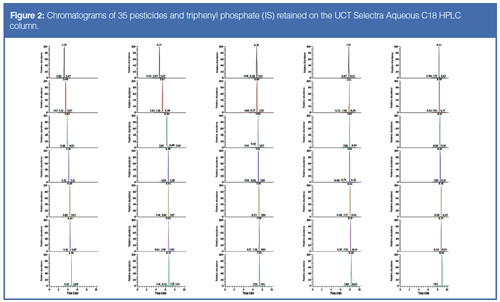
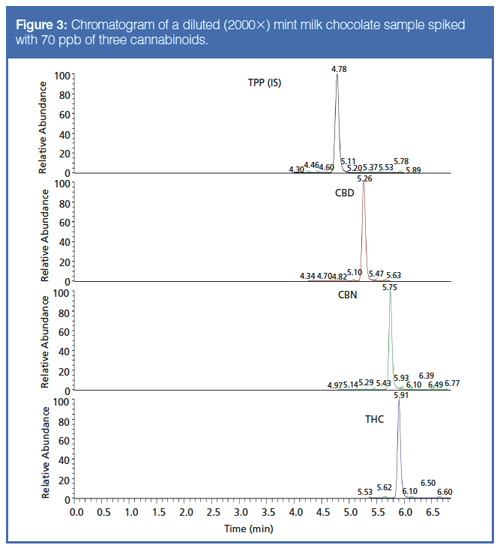
The column oven was maintained at 40 °C, and the samples in the autosampler were kept at 10 °C. The injection volumes were 2 and 5 μL for pesticide and cannabinoid analysis, respectively. Mobile-phase A was 10 mM ammonium acetate in Milli-Q water, and mobileâphase B was methanol with 0.1% formic acid. The mobile-phase flow rate was 300 μL/min. The gradient for pesticides was programmed as follows: 0 min, 0% B; 1–3.5 min, 50% B; 6–9 min, 95% B; and 9.1–14 min, 0% B. For cannabinoid analysis, the gradient program was as follows: 0–0.5 min, 60% B; 3–7 min, 95% B; and 7.1–10 min, 60% B.
Tandem MS was operated with heated electrospray ionization (HESI) in positive mode. The MS/MS conditions were set as follows: spray voltage at 3500 V; sheath gas of nitrogen at 50 arbitrary units; auxiliary gas of nitrogen at 40 arbitrary units; vaporizer temperature at 450 °C; ion transfer capillary temperature at 350 °C; collision gas of argon at 1.5 mTorr; Q1 peak width of 0.4 Da full width half maximum (FWHM); and Q3 peak width of 0.7 Da FWHM. The optimization of the MS/MS transitions was performed individually for each analyte by infusing 1 μg/mL of standard in acetonitrile at 10 µL/min in a 50:50 A–B mobile phase at a flow rate of 300 µL/min. Scheduled selected reaction monitoring (SRM) with a cycle time of 0.5 s was set for data acquisition. The precursor and product ions, collision energies, and S-Lens RF values of the 35 pesticides, IS, and three cannabinoids are listed in Table 1.
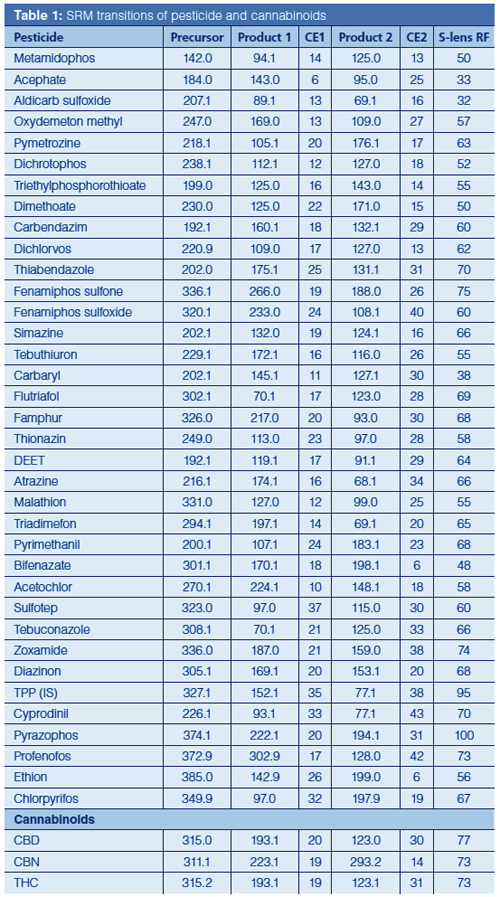
Results and Discussion
Semiquantitative Determination of Pesticide Residues: Pesticide residues were analyzed semiquantitatively because of the lack of negative control samples for each sample matrix, as well as the large number of pesticides at different concentration levels making the standard addition method impractical. Matrixâmatched calibration curves were generated using the post-spiked blank extracts of green tea sample to semiquantify the pesticide residues in edibles and beverages. Appropriate amounts of the pesticide spiking solution were added into the tea extracts to generate six-point matrix-matched calibration curves with concentrations at 5, 10, 25, 50, 100, and 250 ng/mL. The responses were found to be linear (R2 > 0.99) over the entire concentration range. Accuracy and precision results at 10-ng/g and 50-ng/g spiking levels are shown in Table 2.
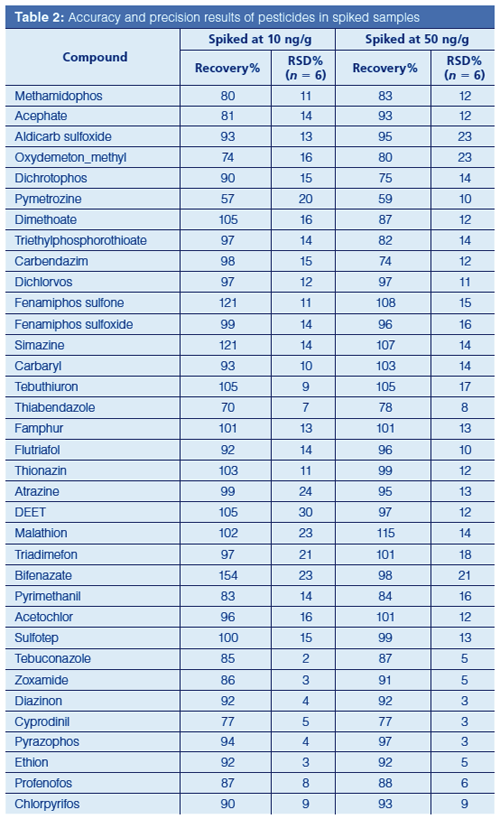
A variety of edibles, including chocolate bars, brownies, hard and gummy candies, CBD oil, and beverage samples, were analyzed for pesticide residues using the QuEChERS extraction and dSPE cleanup method described above, and the results are summarized in Table 3. Four products were found to contain bifenazate at concentrations ranging from 10 to 1221 ng/g, although some of them claimed to be “organically grown” products. The highest concentration was found in a CBD oil sample, where the pesticide might have been enriched when manufacturing the concentrated oil product from the raw plant materials. Bifenazate is commonly used to control mites on agricultural products. Though it is not terribly harmful to humans in comparison to other pesticides, there is a lack of research regarding the health risk of constant consumption of this pesticide. Most pesticide research does not take into account the oral dosing over a long period of time, especially in people with compromised immune systems.
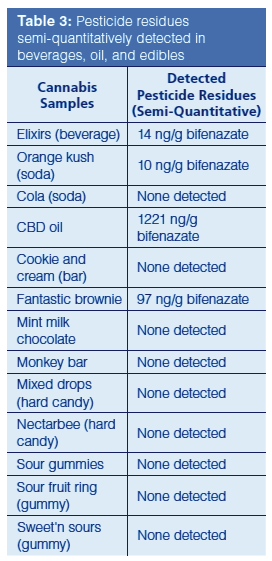
Quantitative Determination of Cannabinoid Content: For cannabinoid analysis, content was quantitated by the standard addition method. Diluted QuEChERS extracts were spiked at +50% and +150% of the stated cannabinoid content. Plotting the peak areas of the diluted sample and the two aforementioned spiked samples allowed for the calculation of cannabinoid concentrations in the diluted samples. Excellent linearity (R2 > 0.995) was observed for all samples tested. An example of the standard addition calibration curve is demonstrated in Figure 4. Calculation of the cannabinoid contents in the original samples was based on the dilution factors and unit conversion factors. The results (in milligrams per pack) were then compared to the stated content on the packaging of each product, as summarized in Table 4. For all of the cannabis samples tested in this study, only 31% (four out of 13 samples) had accurately labelled the total cannabinoid content within ±20% of the stated values.
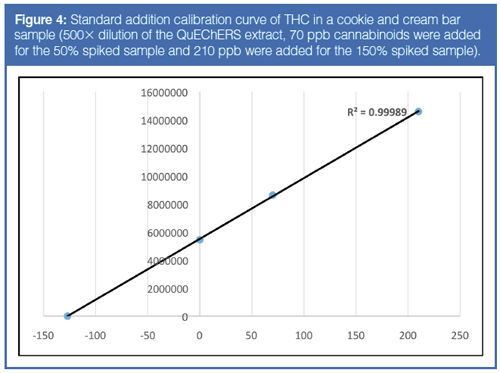
Although the US Food and Drug Administration takes care of monitoring the safe production of the majority of edible products in the United States, marijuana-infused foods do not fall under their jurisdiction because the drug is still considered to be illegal in the eyes of the federal government. Recreational users may be primarily focused on getting their money’s worth from these products, but medicinal users have additional, notable concerns with edibles. Many medicinal consumers do not necessarily want to feel the psychoactive effects of marijuana, but rather just want to combat the symptoms of their specific ailment. If a product is inaccurately labelled, medicinal users run the risk of consuming too much marijuana and thus having undesirable side effects. On the contrary, they also could be unnecessarily suffering from side effects of their illnesses because of an edible product containing less cannabinoids than the suggested dosage amount. These concerns are in addition to the possible presence of unwanted chemical residues, such as pesticides, mycotoxins, and heavy metals.
Conclusion
A fast, reliable, and cost-effective analytical method has been developed for the determination of pesticide residues and cannabinoid contents in cannabis infused edibles and beverages. This method uses the advantages of QuEChERS products to extract 35 pesticides and three cannabinoids (CBD, CBN, and THC) from complex food and beverage matrices. This extraction is then followed by either serial dilution for cannabinoid content analysis, or a dSPE cleanup for the efficient removal of various matrix coextractives, resulting in extracts for trace-level pesticide residue analysis. This hybrid method allows QuEChERS, which is extensively used in the food testing industry, to be used in a forensic or private cannabis laboratory setting.
The developed method has been successfully applied to the analysis of 13 real cannabis edible and beverage samples. For pesticide analysis, bifenazate was present in four out of the 13 tested samples at varied concentrations ranging from 10 to 1221 ng/g. For cannabinoid content analysis, only 31% (four out of 13) of the samples had accurately labelled the total cannabinoid content within ±20% of the stated value, while the majority of samples (eight out of 13, or 62%) were overlabelled (more than 20% below the labelled amount). One sample was found underlabelled which actually contained 40% more THC than stated.
Acknowledgements
Keith Tucker with SPEX SamplePrep LLC is acknowledged for providing the 6770 Freezer mill and 2010 Geno/Grinder for this study. Erik Swiatkowski with UCT is thanked for his help in handling liquid nitrogen when using the SPEX 6770 freezer mill.
References
- A.A. Monte, R.D. Zane, and K.J. Heard, JAMA313(3), 241–242 (2015).
- State Medical Marijuana Laws, National Conference of State Legislators 18 April 2016.
- M. Anastassiades, S.J. Lehotay, D. Stajnbaher, and F.J. Schenck, J. AOAC Int.86(2), 412–431 (2003).
- S.W.C. Chung and B.T.P. Chan, J. Chromatogr. A1217, 4815–4824 (2010).
- S.C. Cunha, S.J. Lehotay, K. Mastovska, J.O. Fernandes, M. Beatriz, and P.P Oliveira, J. Sep. Sci. 30(4), 620–626 (2007).
- Y. Sapozhnikova, J. Agric. Food Chem. 62, 3684–3689 (2014).
- X. Wang and M.J. Telepchak, LCGC Europe 26, 66–77 (2013).
- J. Wang and W. Cheung, J. AOAC Int.99(2), 539–557 (2016).
- M. Villar-Pulido, B. Gilbert-Lopez, J.F. Garcia-Reyes, N.R. Martos, and A. MolinaâDiaz, Talanta 85, 1419–1427, (2011).
- B. Kinsella, S.J. Lehotay, K. Mastovska, A.R. Lightfield, A. Furey, and M. Danaher, Anal. Chim. Acta 637, 196–207 (2009).
- L. Vaclavik, M. Zachariasova, V. Hrbek, and J. Hajslova, Talanta82, 1950–1957 (2010).
- T.H. Kao, S. Chen, C.J. Chen, C.W. Huang, and B.H. Chen, J. Agric. Food Chem.60, 1380–1389 (2012).
- S.C. Cunha, C. Cunha, A.R. Ferreira, and J.O. Fernandes, Anal. Bioanal. Chem. 404, 2453–2463 (2012).
- Y. Ma, Y. Hashi, F. Ji, and J.M. Li, J. Sep. Sci.33, 251–257 (2010).
Xiaoyan Wang, Danielle Mackowsky, Jody Searfoss, and Michael J. Telepchak are with UCT in Bristol, Pennsylvania, USA.
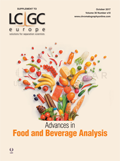
Analytical Challenges in Measuring Migration from Food Contact Materials
November 2nd 2015Food contact materials contain low molecular weight additives and processing aids which can migrate into foods leading to trace levels of contamination. Food safety is ensured through regulations, comprising compositional controls and migration limits, which present a significant analytical challenge to the food industry to ensure compliance and demonstrate due diligence. Of the various analytical approaches, LC-MS/MS has proved to be an essential tool in monitoring migration of target compounds into foods, and more sophisticated approaches such as LC-high resolution MS (Orbitrap) are being increasingly used for untargeted analysis to monitor non-intentionally added substances. This podcast will provide an overview to this area, illustrated with various applications showing current approaches being employed.



